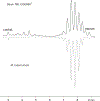Mycobacterium decipiens sp. nov., a new species closely related to the Mycobacterium tuberculosis complex
- PMID: 30204586
- PMCID: PMC6607433
- DOI: 10.1099/ijsem.0.003031
Mycobacterium decipiens sp. nov., a new species closely related to the Mycobacterium tuberculosis complex
Abstract
Two mycobacterial strains with close similarity to the Mycobacterium tuberculosis complex (MTBC) were isolated from cutaneous lesions of patients in the USA and Italy. At the phenotypic level, similarities to the MTBC included slow growth rate, rough morphotype of the unpigmented colonies and nearly identical high-performance liquid chromatography profiles of mycolic acids. In contrast to the MTBC, the strains were niacin- and nitrate-negative, and catalase-positive both at 68 °C and in semi-quantitative tests. The clinical isolates were more closely related to M. tuberculosis than to any other known mycobacterium and scored positive with commercial DNA probes (Hologic AccuProbe M. tuberculosis). Both average nucleotide identity and genome-to-genome distance suggested the strains are different from the MTBC. Therefore, given the distinguishing phenotypic and genomic-scale differences, we submit that the strains belong to a new species we have named Mycobacteriumdecipiens with type strain TBL 1200985T (=ATCC TSD-117T=DSM 105360T).
Keywords: Mycobacterium decipiens; Mycobacterium tuberculosis complex; average nucleotide identity; whole genome sequencing.
Conflict of interest statement
Conflicts of interest
The authors declare that there are no conflicts of interest.
Figures



Similar articles
-
Characterization of 17 strains belonging to the Mycobacterium simiae complex and description of Mycobacterium paraense sp. nov.Int J Syst Evol Microbiol. 2015 Feb;65(Pt 2):656-662. doi: 10.1099/ijs.0.068395-0. Epub 2014 Dec 8. Int J Syst Evol Microbiol. 2015. PMID: 25487637
-
Mycobacterium talmoniae sp. nov., a slowly growing mycobacterium isolated from human respiratory samples.Int J Syst Evol Microbiol. 2017 Aug;67(8):2640-2645. doi: 10.1099/ijsem.0.001998. Epub 2017 Aug 15. Int J Syst Evol Microbiol. 2017. PMID: 28809146
-
Mycobacterium shinjukuense sp. nov., a slowly growing, non-chromogenic species isolated from human clinical specimens.Int J Syst Evol Microbiol. 2011 Aug;61(Pt 8):1927-1932. doi: 10.1099/ijs.0.025478-0. Epub 2010 Sep 10. Int J Syst Evol Microbiol. 2011. PMID: 20833878
-
Mycobacterium iranicum sp. nov., a rapidly growing scotochromogenic species isolated from clinical specimens on three different continents.Int J Syst Evol Microbiol. 2013 Apr;63(Pt 4):1383-1389. doi: 10.1099/ijs.0.043562-0. Epub 2012 Jul 27. Int J Syst Evol Microbiol. 2013. PMID: 22843713
-
Mycobacterium aquaticum sp. nov., a rapidly growing species isolated from haemodialysis water.Int J Syst Evol Microbiol. 2017 Sep;67(9):3279-3282. doi: 10.1099/ijsem.0.002103. Epub 2017 Aug 22. Int J Syst Evol Microbiol. 2017. PMID: 28829035
Cited by
-
Comparative Genomic and Transcriptomic Analyses of Mycobacterium kansasii Subtypes Provide New Insights Into Their Pathogenicity and Taxonomy.Front Cell Infect Microbiol. 2020 Mar 24;10:122. doi: 10.3389/fcimb.2020.00122. eCollection 2020. Front Cell Infect Microbiol. 2020. PMID: 32266172 Free PMC article.
-
Evolution and emergence of Mycobacterium tuberculosis.FEMS Microbiol Rev. 2024 Mar 1;48(2):fuae006. doi: 10.1093/femsre/fuae006. FEMS Microbiol Rev. 2024. PMID: 38365982 Free PMC article. Review.
-
Genomic and phenotypic characterization of Mycobacterium tuberculosis' closest-related non-tuberculous mycobacteria.Microbiol Spectr. 2024 Jun 4;12(6):e0412623. doi: 10.1128/spectrum.04126-23. Epub 2024 May 3. Microbiol Spectr. 2024. PMID: 38700329 Free PMC article.
-
Mycobacteria that cause tuberculosis have retained ancestrally acquired genes for the biosynthesis of chemically diverse terpene nucleosides.PLoS Biol. 2024 Sep 30;22(9):e3002813. doi: 10.1371/journal.pbio.3002813. eCollection 2024 Sep. PLoS Biol. 2024. PMID: 39348416 Free PMC article.
-
Shared Pathogenomic Patterns Characterize a New Phylotype, Revealing Transition toward Host-Adaptation Long before Speciation of Mycobacterium tuberculosis.Genome Biol Evol. 2019 Aug 1;11(8):2420-2438. doi: 10.1093/gbe/evz162. Genome Biol Evol. 2019. PMID: 31368488 Free PMC article.
References
-
- Saito H, Iwamoto T, Ohkusu K, Otsuka Y, Akiyama Y et al. Mycobacterium shinjukuense sp. nov., a slowly growing, non-chromo-genic species isolated from human clinical specimens. Int J Syst Evol Microbiol 2011;61:1927–1932. - PubMed
-
- Tortoli E, Rogasi PG, Fantoni E, Beltrami C, de Francisci A et al. Infection due to a novel mycobacterium, mimicking multidrug-resistant Mycobacterium tuberculosis. Clin Microbiol Infect 2010;16: 1130–1134. - PubMed
-
- van Ingen J, Al-Hajoj SA, Boeree M, Al-Rabiah F, Enaimi M et al. Mycobacterium riyadhense sp. nov., a non-tuberculous species identified as Mycobacterium tuberculosis complex by a commercial line-probe assay. Int J Syst Evol Microbiol 2009;59: 1049–1053. - PubMed
-
- Kent PT, Kubica GP. Public Health Mycobacteriology. A Guide for the Level III Laboratory. Atlanta: U.S: Department of Health and Human Services; 1985.
MeSH terms
Substances
Grants and funding
LinkOut - more resources
Full Text Sources
Other Literature Sources
Medical
Molecular Biology Databases

